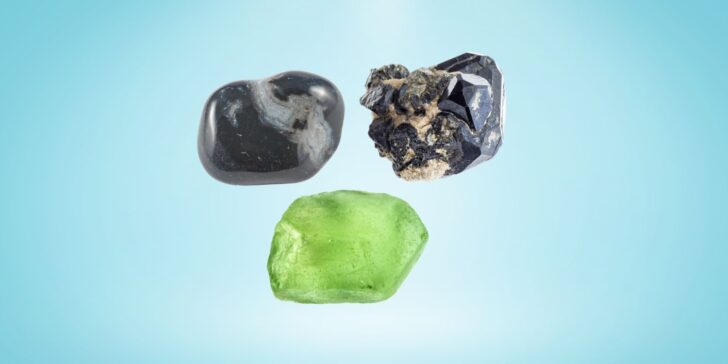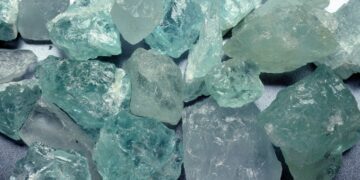Did you know August actually has three birthstones? Get ready to learn about all three of these beautiful and remarkable birthstones!
Sardonyx was the original unofficial birthstone for August for centuries. When the National Association of Jewelers began promoting birthstones in 1912, peridot was added as August’s second birthstone.
Spinel was added as a third in 2016 in an effort to modernize the birthstone list. Here are 24 things we bet you didn’t know about the three birthstones of August.
Peridot is a silicate mineral, meaning it is made up of silicon and oxygen. It is a variety of the common silicate, olivine.
While olivine is a plentiful material, gem-quality peridot is, in fact, quite rare. This rarity is caused by peridot’s unstable structure on Earth’s surface.
Peridot is one of the few gemstones only come in one color, in this case, a shade of olive green. The intensity of this green depends on how much iron is in the gemstone’s crystal structure.
While gems commonly form in the Earth’s crust, peridot is one of only two gems that do so in the molten rock of Earth’s upper mantle.
Peridot can even be found in meteorites! This peridot from outer space differs from the kind found on Earth as it contains no nickel.
Peridot can also be found in lava flows. But, while these can be a particularly rich source of olivine, actual gem-quality peridot from these sources is scarce.
One of NASA’s telescopes identified olivine/peridot in the gassy cloud of a forming star, with crystallized particles swirling in the currents like green rain.
The vast majority of the world’s peridot supply comes from Arizona‘s San Carlos Apache Reservation.
The world’s largest cut and polished peridot is 310 carats and is on display in the Smithsonian. For perspective, an average diamond engagement ring is only one or two carats in size.
Sardonyx has a reddish appearance with white stripes. This pattern is formed due to alternating layers of sard and onyx, which are both types of the mineral chalcedony.
Onyx is chalcedony that’s striped white, grey, and black. Onyx got its name from the Latin word for “fingernail” or “claw” because the white bands are the same color as nails.
Sard is another type of chalcedony. It’s primarily red, orange, or brown because it contains iron oxide. The mineral sard takes its name from an ancient city called Sardis, located in what is now Turkey, as the mineral was common there.
Sardonyx has been popular for thousands of years, all the way back to Ancient Egypt. It has been used to create bas-relief cameos in stone, commonly depicting the faces of gods, kings, heroes, and beauties. These works of art are called intaglios, from the Italian word meaning “to engrave.”
Ancient Roman rulers used signet rings and seals made of sardonyx to imprint wax insignia on important documents because melted wax doesn’t stick to it.
While sardonyx is found around the world, some of the finest examples come from India. The sharp, defined edges between the layers of sard and onyx are what make these specimens particularly noteworthy.
Spinel (spin-ELLE) comes from the Latin word “spinella,” meaning “thorn,” because its pointed shape imitates the shape of a thorn. Spinel usually takes the form of an octahedron, with two 4-sided pyramids stuck together at the base.
This beautiful gemstone is made of magnesium, aluminum, and oxygen and has an isometric crystal structure.
Pure spinel is as clear as glass. Various mineral impurities imbue it not just with every color of the rainbow but with grays and black too!
Spinel is found in the same places where sapphires and rubies are mined, leading to confusion because they look nearly identical. For centuries, any red-colored gem was called a ruby, and any blue-colored gem was a sapphire.
In 1783, French mineralogist Jean-Baptiste Louis Romé de l’Isle developed methods of distinguishing identical-looking minerals by testing their mineral makeup. This was the first revelation that many “rubies” were actually spinel.
The most famous spinel is called “The Black Prince’s Ruby.” It was set in the British Imperial State Crown above the Cullinan II diamond. Only later was it found that the 170-carat stone is spinel and not ruby.
Although red-colored spinel is rarer than ruby and is often much larger than typical rubies, it’s still usually available at one-tenth of the price of a genuine ruby.
Synthetic spinel also has industrial uses. It provides heat-resistant coatings on things such as metal tools. It’s also added to bricks and ceramics.
Because synthetic spinel is available in almost every color, it can be used to imitate nearly every other gemstone.

And there you have it! People born in August are fortunate enough to have three such divergent gems to pick from to reflect their personality and pocketbook.
Each unique mineral tells a different story. Kings and queens, leaders and laypeople, jewelers and geologists have all brought us this magnificent selection of birthstones to celebrate the month of August.


















